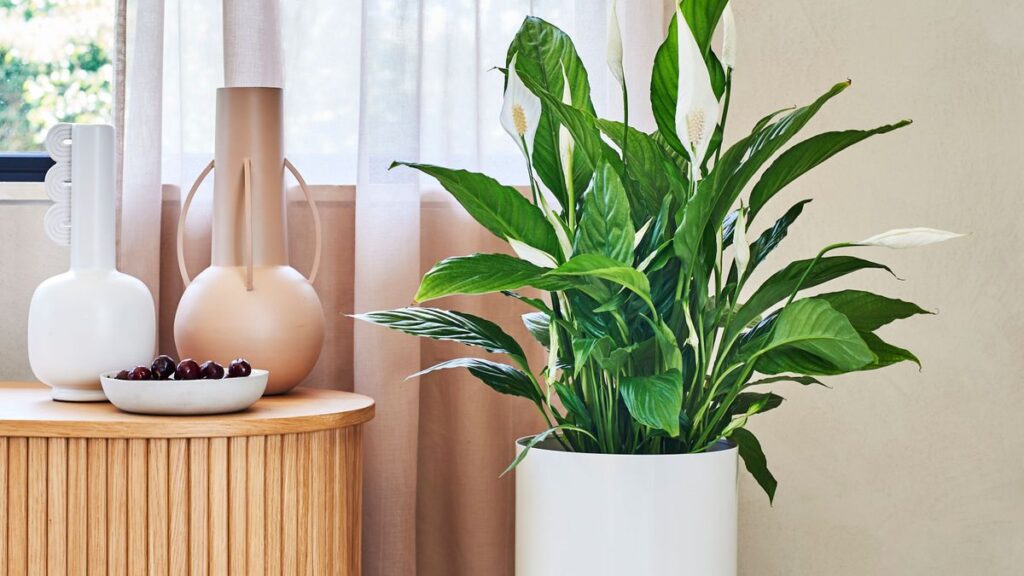Peace lilies are a favourite among many houseplant owners, and make for an air-purifying, stylish addition to any home. However, if you don’t know how often to water peace lilies, this easy-to-care-for plant can start drooping before your eyes.
Despite being generally very resilient, small mistakes in watering can cause larger problems for your peace lily’s health – through both over and under-watering. Knowing when to water your peace lily can take some time to get the hang of, but is an important skill to get to grips with in order to help this zen plant thrive.
Fortunately, it is easy to learn how to care for peace lilies. ‘Peace lilies should be watered around once a week, but this can vary depending on their environment,’ says Jo Lambell, founder of Beards & Daisies. As Jo points out, this is general guidance, and a number of environmental factors can influence how often to water peace lilies.
How to tell if your peace lily needs watering
One foolproof way of checking if your peace lily needs watering is by keeping an eye on the moisture levels of its soil. ‘The easiest way is to touch the soil: if the top inch feels dry, the plant needs water,’ advises Jo.
You can also check if your plant needs more water by checking the weight of the pot. If you pick it up and the pot feels empty, it’s usually a sign that your plant needs more water.
Peace lilies will also tell you when they need a drink with changes in their physical appearance.
‘Another sign is drooping leaves, as peace lilies tend to drop when thirsty but bounce back quickly after watering,’ adds Jo. Crisp, dry leaf edges are also a telltale sign that your lily could do with a drink.
How often to water your peace lily in winter
The amount of water a peace lily will need changes throughout the seasons. ‘In warmer months, they may need more regular watering, while in winter, they require less as the growth slows down,’ says Jo.
Angela Slater, gardening expert at Hayes Garden World agrees, saying you should water your peace lily ‘roughly every 2-3 weeks in winter, but in summer it may need watering every couple of days.’
However, there’s no hard and fast rule about how often to water your peace lily, and the amount of water your plant needs will depend on different factors in your home.
Peace lilies like bright, indirect light and high humidity, the latter of which can be affected if you keep the heating on throughout the colder months. It’s also important to keep your plants out of cold draughts, as this will affect the humidity too.
If keeping your plant at the right humidity is a concern, buying a plant mister can mitigate this. ‘Misting can help increase humidity, especially in dry environments, but it’s not essential for it,’ says Jo, adding: ‘Placing a tray of water and pebbles nearby can also help maintain humidity.’ You can also mist your plant in the summer months to keep it hydrated in hotter weather.
Generally, choosing the right spot within your home for your peace lily is a good way to regulate its watering needs. ‘A light-filled bathroom is a perfect spot for most peace lilies as they’ll thrive in the humidity,’ says Claire Bishop, senior plant buyer at Dobbies Garden Centres – just make sure it’s kept out of direct light.
If you’re still unsure about how often to water you peace lily, then it might be worth investing in a self-watering pot – like this LECHUZA Self-Watering Plant Pot on Amazon.
FAQs
Can you overwater a peace lily?
Overwatering is one of the most common issues when keeping a peace lily, and can lead to drooping yellow leaves, and in severe cases, root rot. You can tell if your peace lily has root rot if the soil stays constantly damp, grows mould, or smells. The roots will also be soft and mushy.
What is the lifespan of a peace lily?
‘With proper care, peace lilies can live for 3–5 years on average, but some can survive much longer with really good maintenance,’ says Jo Lambell, founder of Beards & Daisies.
What does an unhealthy peace lily look like?
There are many ways that your peace lily can tell you that it’s unhealthy. According to Jo, these include:
- Drooping leaves: this usually means your peace lily needs watering
- Yellow leaves: this indicates overwatering
- Brown leaf tips: this may be a sign of low humidity or too much fertiliser
- Wilting: this can mean the plant is too dry or is suffering from root rot.
Luckily, there are many ways to revive a peace lily: they are resilient plants which can quickly bounce back to life. ‘Trimming dead flowers at the base of the stem helps with new growth’ too, says Jo.
Read the full article here
